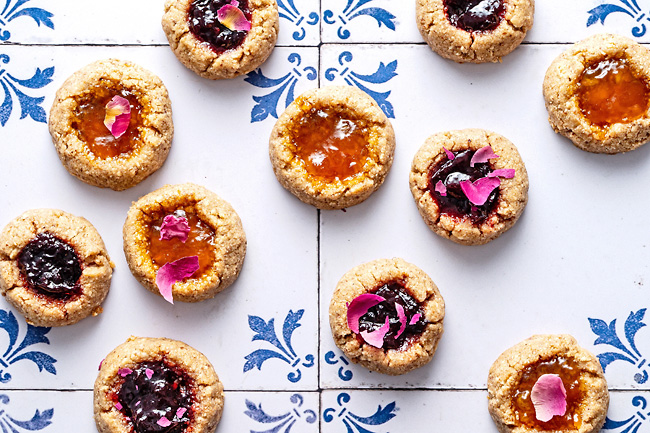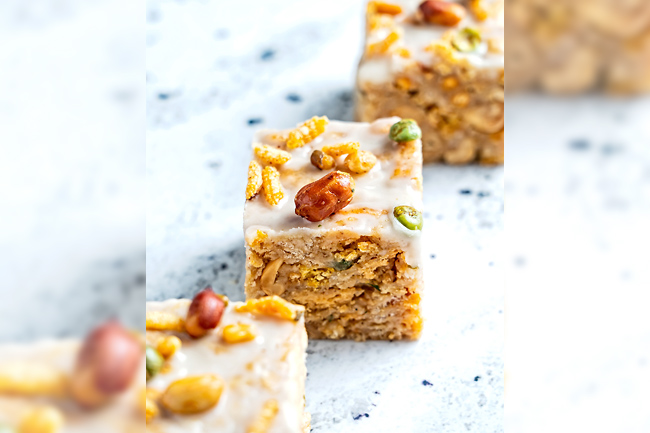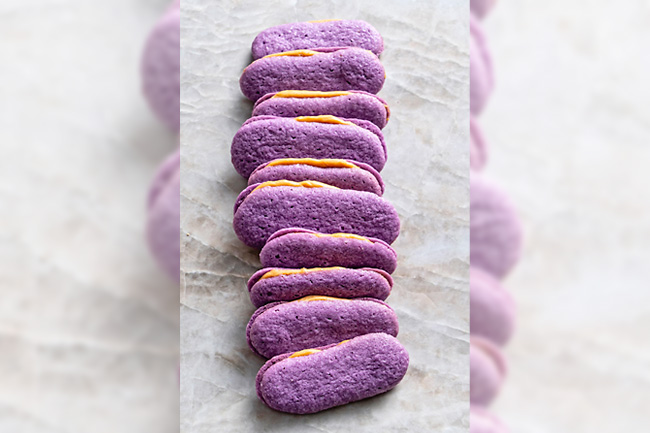Becky Krystal
THE WASHINGTON POST – So much about the holiday season is centred on tradition, not to mention repetition. Every year, you may pull out the same decorations, the same cozy flannel pajamas, the same music playlist. You probably even gather with many of the same people, with whom you cook the same food. And yet you can still have a completely different experience every single time.
That’s like baking in a lot of ways. So many recipes feature the same major staples – butter, sugar, flour, spices, chocolate – and still, the variations are endless.
We’ve been publishing an annual holiday cookie collection for 18 years now, and I’m always amazed and elated by the ideas that come from the chefs, cooks and authors we work with to bring you this reader-favourite feature. If you think you’ve seen it all when it comes to cookies, these recipes just might change your mind.
CARDAMON AND ROSE THUMBPRINT COOKIES
INGREDIENTS
– One cup whole, raw almonds
– One cup chickpea flour
– Half cup old-fashioned rolled oats
– Two-thirds cup granulated sugar
– Two teaspoons ground cardamom
– One teaspoon ground cinnamon
– Quarter teaspoon fine salt
– Half cup light olive oil or neutral oil, plus more as needed
– One to two teaspoons rose water
– Half cup cherry jam or apricot jam
– Dried rose petals, for garnish




DIRECTIONS
Position a rack in the middle of the oven and preheat to 350 degrees Fahrenheit. Line two large, rimmed baking sheets with parchment paper. In the bowl of a food processor, combine the almonds, chickpea flour, oats, sugar, cardamom, cinnamon and salt. Pulse to break down the almonds and oats until the mixture forms a coarse meal, 10 to 15 pulses.
Add the oil and one teaspoon of the rose water. Pulse a few times, scrape down the bowl with a spatula, and continue to pulse until the almonds and oats are no longer visible and the dough comes together, another 15 to 20 pulses, adding more oil as needed, one teaspoon at a time. The dough should hold its shape when you squeeze a piece of it, as well as start to form larger clumps around the blade.
In a small bowl, stir the jam to loosen it, as needed. If desired, add one teaspoon more of the rose water. Roll the dough into tablespoon-size balls weighing about 20 grammes. Place the balls on the prepared baking sheet, spaced about one and half inches apart. Gently press a hole in the middle of each ball with your thumb, and use your fingers to shape the cookies into even rounds. Fill each indentation with a scant one teaspoon of the jam.
Bake, one sheet at a time, for 18 to 20 minutes, or until the cookies are lightly browned on the bottom. Let the cookies cool on the pan on a wire rack. Serve warm or at room temperature.
CONCHA COOKIES
INGREDIENTS
For the crust
– One cup all-purpose flour
– Two-thirds cup granulated sugar
– Generous one-third cup vegetable shortening (may substitute softened unsalted butter)
– One teaspoon vanilla extract
– One to two drops pink gel food colouring
FOR THE COOKIES
– Two and one-third-cups cake flour, plus more as needed
– Half teaspoon baking powder
– Quarter teaspoon fine salt
– Eleven tablespoons unsalted butter, softened
– Three-quarter cup granulated sugar
– One large egg
– One teaspoon orange blossom water
– One teaspoon vanilla extract
– Finely grated zest of one orange
DIRECTIONS
Make the crust: In the bowl of a stand mixer fitted with the paddle attachment, or using a large bowl and a hand mixer, beat together the all-purpose flour, sugar, shortening and vanilla on medium speed until a soft dough forms, three to four minutes. Add the food colouring and mix again on medium until evenly distributed.
You need the fat to emulsify, so don’t worry about overmixing. Transfer to a medium bowl and wipe out the mixer bowl to make the cookie dough.
Make the cookies: In a medium bowl, whisk together the cake flour, baking powder and salt until thoroughly combined.
In the bowl of a stand mixer fitted with the paddle attachment, or using a large bowl and a hand mixer, beat together the butter and sugar on medium until smooth, creamy and somewhat fluffy, three to five minutes. Add the egg and beat again on medium until combined, followed by the orange blossom water, vanilla and orange zest, and mix again until incorporated; scrape down the bowl.
Add the flour mixture to the bowl and mix on medium-low until a soft dough forms, one to two minutes. Cover the bowl and refrigerate the dough for one hour.
Position racks in the upper and lower thirds of the oven and preheat to 350 degrees Fahrenheit. Line two large, rimmed baking sheets with parchment paper.
Use your hands to pull off heaping one-tablespoon portions of dough and roll them into smooth balls about one inch wide, setting them about two inches apart on the prepared sheets. Using your palm, gently press to flatten until they are a little less than two inches wide.
Pull off two-teaspoon portions of the crust mixture and roll into smooth balls. Press between your hands and flatten into something like a small tortilla, placing each portion on top of the individual dough balls. Aim to have the crust portions slightly wider than the cookie balls so that when placed on top, they drape over the sides somewhat.
In a bowl or in a little pile on the counter, dip the concha cutter in a few tablespoons of cake flour. Use the cutter to press the seashell pattern on top of the dough balls. Press just hard enough to flatten the cookies a bit more and leave an imprint on the surface. Don’t cut all the way down.
Be sure to dust the cutter before you press each dough ball.
Bake the two sheets for nine to 12 minutes, just until the edges of the cookies start drying, rotating from top to bottom and front to back halfway through. You don’t want to add much colour to the cookies. Let the cookies rest on the pan for a few minutes, then transfer to a wire rack to cool completely.
SALTED ‘KACANG PUTEH’ CRISPED RICE TREATS
INGREDIENTS
For the bars
– Non-stick cooking spray
– Six tablespoons virgin or refined coconut oil
– One teaspoon garam masala
– Quarter cup agave syrup
– Two tablespoons coconut cream or other plant-based cream
– One bag marshmallows
– One teaspoon vanilla extract
– Three-quarter teaspoon fine salt
– Three-quarter cup natural peanut butter, well-stirred and at room temperature
– Two cups savoury snacks, such as Bombay mix, chevda mix or murukku, larger noodles broken up into pieces no larger than two inches, plus more for optional garnish
– One cup vegetable chips of choice, such as potato or tapioca, crushed, plus more for optional garnish
– Half cup roasted nuts, chickpeas or other legumes, or a mix, plus more for optional garnish
– Two cups puffed rice cereal, such as Rice Krispies
FOR THE GLAZE
– Half cup confectioners’ sugar, plus more as needed
– One tablespoon thick yoghurt
– One teaspoon fresh lemon juice, plus more as needed
DIRECTIONS
Make the bars: Spray an eight-inch square baking dish or pan with non-stick spray, then line it with two crisscrossed pieces of parchment paper long enough to have a generous overhang on all sides. Have ready a piece of eight-inch square of parchment paper or plastic wrap.
In a medium pot over medium-low heat, melt the coconut oil with the garam masala, stirring occasionally with a heatproof spatula just until the spices are fragrant, three to five minutes.
Add the agave and coconut cream, stirring to combine. Once the mixture is emulsified, stir in the marshmallows until completely coated and reduce the heat to low. Patiently stir until the marshmallows are melted and the mixture is smooth, five to seven minutes; remove from the heat.
Stir in the vanilla and salt. Gently fold in the peanut butter, four to five strokes, leaving streaks of marshmallow visible. The mixture will start to stiffen, but do not panic: The goal is to incorporate some of the peanut butter, while having the mixture still workable. Less stirring is better than too much.
Add the rice cereal, snacks, chips and nuts, chickpeas or legumes and mix vigorously until everything is well-coated and incorporated, making sure to scrape around the sides and bottom of the pot.
Working quickly, scoop all of the mixture into the prepared pan. Using the prepared sheet of parchment paper or plastic wrap, lightly and deftly flatten the gooey mixture all around the pan, evenly patting to smooth the surface and fill all the corners. Be gentle, yet firm. Avoid forcefully compressing the mixture, which will result in stiff, brick-hard bars instead of chewy, soft-set ones. Transfer to the refrigerator to chill completely (uncovered is okay), at least two hours and up to one day.
Make the glaze: When ready to glaze the slab, in a small bowl, whisk together the confectioners’ sugar, yogurt and lemon juice until combined. Adjust the consistency using more sugar, yoghurt and/or lemon juice until you achieve a fairly thin glaze that will create an even but translucent layer on top of the treats. If you prefer something thicker and sweeter, add more sugar.
Pour the glaze over the slab in the pan. Use an offset spatula or small butter knife to spread the coating into an even layer, reaching the edges. If desired, top with additional cereal, snacks, chips and/or roasted nuts.
Return to the refrigerator to let the glaze set, 10 to 15 minutes.
When ready to serve, remove from the refrigerator and let sit at room temperature for 10 minutes before slicing into 16 squares with a sharp knife.
UBE LENGUA DE GATO
INGREDIENTS
For the cookies
– Scant one cup granulated sugar
– Eight tablespoons unsalted butter, softened
– Pinch fine salt
– One teaspoon ube extract
– One and one-third all-purpose flour
– Two large egg whites
For the ganache
– 300 grammes Valrhona Dulcey caramelised white chocolate, chopped (may substitute chopped white chocolate, do not use chips)
– 100 grammes yuzu marmalade (may substitute orange marmalade)
– Three tablespoons heavy cream
DIRECTIONS
Make the cookies: Position a rack in the middle of the oven and preheat to 325 degrees Fahrenheit. Line two large, rimmed baking sheets with parchment paper.
In a stand mixer fitted with the paddle attachment, or using a large bowl and a hand mixer, beat the sugar, butter and salt on medium speed until light and fluffy, two to three minutes.
Add the ube extract, if using, and mix on medium until thoroughly combined. Scrape down the bowl with a flexible spatula.
Add half the flour and beat on medium until homogenous. Add half the egg whites, beating again until incorporated. Repeat with the remaining flour and egg whites.
Transfer the batter to a pastry bag fitted with a large, round tip that is approximately one-third inch in diameter. Hold the bag perpendicular to the baking sheet, with the tip about one-eighth inch above the surface.
Slowly pipe a two-inch-long line, allowing the bag to hover above the pan as you pipe, so that the batter spreads out a bit, aiming for a line that is about three-quarter-inch wide.
Repeat until you fill up the two baking sheets, spacing each line about one inch apart; you should get about 30 wafers per sheet.
Bake, one sheet at a time, for 10 to 12 minutes, or until the edges are set and the centres are puffed (they will settle a bit after cooling). Let cool on the pan for five minutes, then transfer to a wire rack to cool completely.
Repeat piping and baking the remaining dough, allowing the baking sheets to cool completely before proceeding with more batches. At this point, the cookies can be stored until needed.
Make the ganache: In a microwave-safe bowl, heat the chocolate in one-minute bursts on HIGH until melted, stirring after each burst.
In a small saucepan over medium heat, combine the marmalade and cream, and bring to a simmer, stirring occasionally.
Transfer the melted chocolate and cream mixture to a blender and puree on high until smooth and homogenous.
Transfer to a medium bowl and let cool slightly. The ganache is best used right away, as refrigeration makes it set very firmly.
Assemble the sandwich cookies: Line a large, rimmed baking sheet with parchment paper and arrange half of the cookies, flat side up, on the sheet.
Using an offset spatula or butter knife, spread about one teaspoon of the ganache onto the overturned cookies and place the remaining cookies on top to form sandwiches. Serve, or transfer to a container to store.





